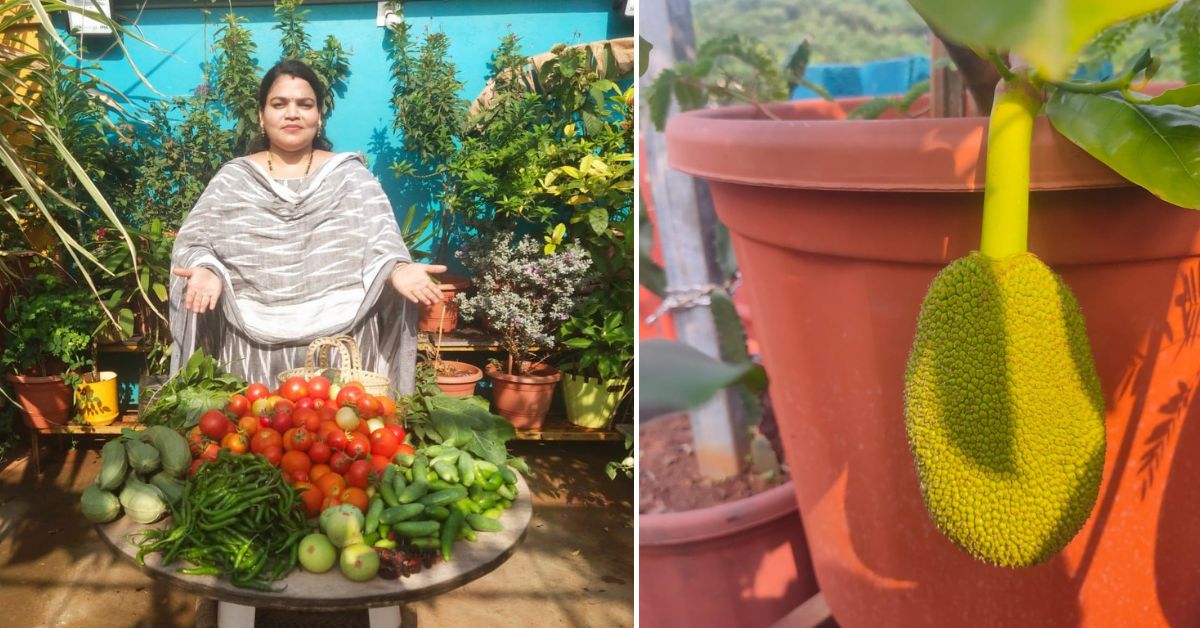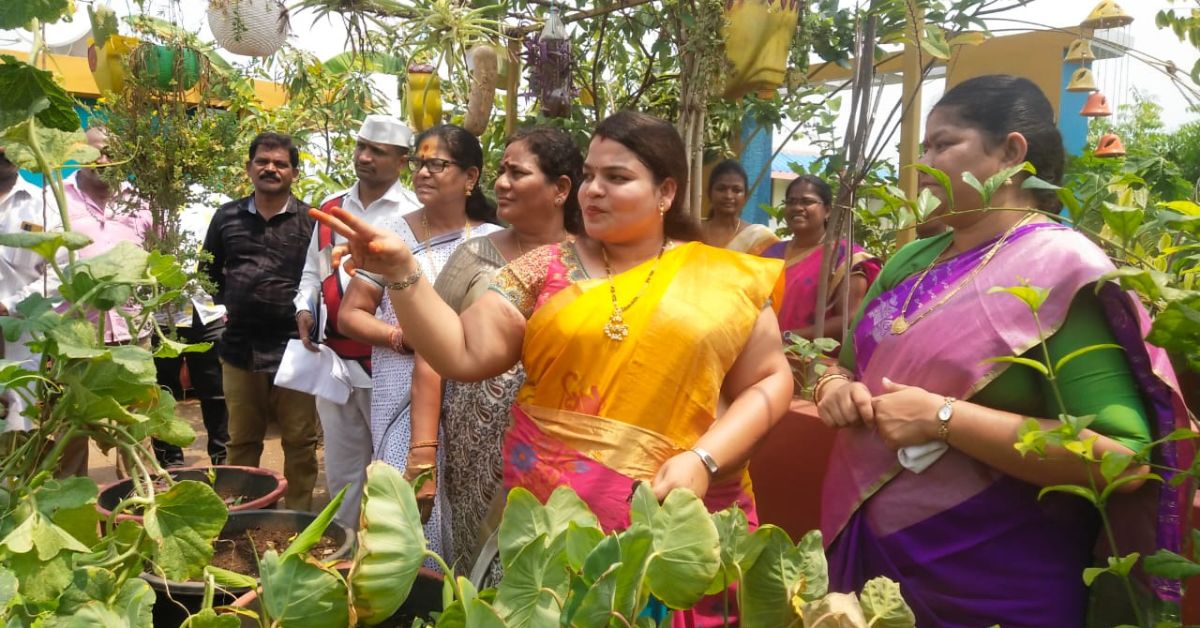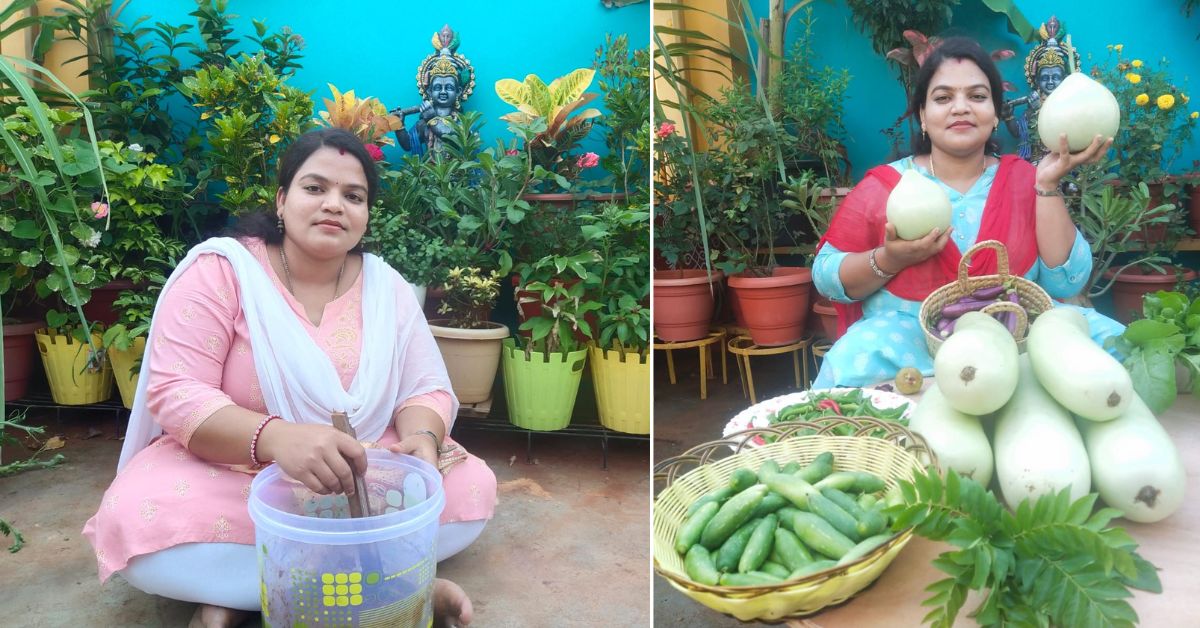As she stepped onto a large stage amid a round of applause, homemaker Bangaru Jhansi had never imagined standing in front of M Venkaiah Naidu, former vice president of India. But last year on 14 October, the Andhra Pradesh resident received the prestigious Dr IV Subba Rao Rythu Nestham award from the former vice president for her impressive terrace garden.
“I was so glad to meet Venkaiah Naidu sir. He congratulated me for my work. It was such a surprising and proud moment for me; I cannot describe it in words,” Bangaru tells The Better India.
“After receiving the award, I feel more dutiful towards encouraging others to take up terrace gardening. I wish that every Indian household should grow their own food for consumption,” she adds.

The 28-year-old has set up a lush green jungle on her terrace spread across an area of 800 square feet. With a wide variety of ornamental and medicinal plants, green leafy vegetables, flowers, and large fruit trees like oranges and mangoes, her terrace garden has become a centre for sustainable farming — drawing the attention of notable dignitaries including the Mayor of Vishakhapatnam Hari Venkata Kumari.
In a conversation with The Better India, Bangaru shares what makes her terrace garden unique.
Building a green oasis on a terrace
Born and brought up in Visakhapatnam, the BCom graduate worked as a manager for three years before her marriage in 2021.
“When I came to my husband’s home, he did not have any plants at all. I took my hobby of gardening from my parent’s home to my in-laws’. So, after a month of my marriage, I started planting a variety of trees,” smiles Bangaru, who gradually turned their terrace into a blooming green oasis with 600 plants.
Since childhood, she was inspired by her grandmother to grow her own food. “I used to learn a lot of gardening techniques from my grandmother. Other than this, I would study a book by Cho Han-kyu, a South Korean farmer who promotes natural farming. This helped me set up a healthy garden,” she says.

“Several farmers are forced to use chemical fertilisers like urea and pesticides to boost crop yield. This always pushed me to grow healthy fruits and vegetables organically and lead a healthy lifestyle,” shares Bangaru.
“Also, there is a vast difference between the quality of our produce and what we get in the market. Our vegetables and fruits have distinctive aromas and are sweeter compared to the market ones which are usually tasteless,” she adds.
Today, the urban gardener grows at least 85 varieties of plants and tall fruit trees — including brinjals, okra, tomatoes, lettuce, mint, watermelon, drumsticks, spring onions, star-fruits, three kinds of mangoes, yellow and red coloured jackfruits, sweet lime, two kinds of oranges, Barbados cherries, strawberries, blueberries, mulberries, custard apple, amla, papaya, grapes, sugarcane, apple, dragon fruits, litchies, guavas, and much more.
Bangaru shares that she dedicates at least three hours a day to looking after her terrace garden. Over the years, she has carefully nurtured tall fruit trees and vegetables by crafting unique fertilisers, composting techniques, and pesticides.

She shares a few secret techniques that she applies in her rooftop garden.
Tips to grow a thriving urban garden on the terrace
Prune the grafted trees: Bangaru suggests pruning the plants before the onset of their favourable season.
“This prepares the plants for good growth and improved air circulation. Also, by pruning, we remove vulnerable parts of the plant and minimise the risk of pest damage,” she adds.
Prepare the potting mix: Bangaru shares that the perfect potting composition comprises 30 percent vermicompost/kitchen waste compost/cow dung, 30 percent soil, 30 percent cocopeat, and 10 percent neem cake.
“I transfer the potting mix into a large container or pot and then plant the saplings. This potting mix contains only a handful of soil so it does not add burden to the terrace weight,” she adds.

When to add biofertilisers: After plantation, Bangaru suggests adding biofertilisers and liquid fertilisers in the pots after three months. She shares the composition of one of her trichoderma-enriched biofertilisers.
“Take 100 kg of cow dung, 10 kg of neem powder, and two kg of trichoderma viride. Mix the ingredients and sprinkle some water over it. Cover it with a cotton cloth and keep them under shade. After seven days, white-coloured good bacteria will have formed. Then, directly mix the compost with cow dung and add to the soil,” she explains.
Add liquid fertiliser to boost yield: Bangaru says that she uses a unique fish amino acid biofertiliser that promotes healthy growth and development of plants by regulating phototropism and photosynthesis, and stimulating carbon and nitrogen metabolism.
As the name suggests, the fertiliser is made using fish!

“Take 1 kg of sea fish and 1 kg of jaggery. Mix it in a terracota pot or plastic container with the help of a stick. Then, cover it with a cotton cloth and keep it under shade,” she explains.
“Every morning and evening, stir it in a clockwise direction. The fertiliser will be ready after 15 days. Take 10 ml of fish amino acid and dilute it in five litres of water, and then, spray it on the leaves and under soil roots of the plants,” she suggests.
Bangaru also suggests giving fruit-fermented juices to plants similar to how it is given to pregnant women; plants also crave citrus fruits before flowering and fruiting!
How to remove pests: The urban gardener suggests spraying neem oil to get rid of insects like mealybugs.
“Firstly, remove the pests manually. Later on, spray neem oil every week. If you still spot the pests on the plant, spray a mixture of chillies and garlic paste mixed in rice water. This is sure to work wonders,” she shares.
Edited by Pranita Bhat. All photos: Bangaru Jhansi.
No comments:
Post a Comment